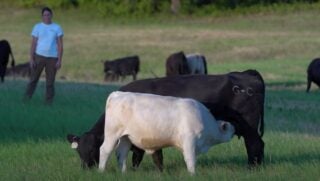You’ve made it through calving season successfully, now when should you start to vaccinate the young bovines?
“Producers should consider vaccinating calves at 2 to 4 months of age, depending on the operation,” said Dr. DL Step, professional services veterinarian, Boehringer Ingelheim.
Colostrum consumed by a newborn calf provides protection against infectious diseases. However, this protection is only temporary, lasting a few weeks to months, and calves must start building their own immunities. That’s why it’s important to vaccinate during this time of transition to help protect the calf until weaning age.
The following are three key benefits of incorporating pre-weaning vaccinations on your operation.
1. Reduced stress
During weaning, calves are faced with stressors such as castration, transportation, disease challenges, weather fluctuations, dietary changes, and more. Stress can cause immunosuppression in a calf, decreasing its ability to respond to disease-causing pathogens and vaccines, making it susceptible to respiratory disease.
“Early vaccination gives calves the opportunity to stimulate their immune systems to work at optimum levels,” said Dr. Step.
2. Enhanced BRD and BVDV protection
Bovine respiratory disease (BRD) is the top health and economic issue facing the beef industry today. Once calves are affected by BRD, there are both immediate and long-lasting effects on performance. Studies have shown that calves challenged by BRD could weigh up to 36 pounds less at weaning than their healthy herd mates. Early vaccination can help producers prepare calves for challenges they may face during weaning time, ensure calves are less susceptible to becoming infected with pathogens and have a more rapid immune response to the various pathogens that cause BRD.
Bovine viral diarrhea virus (BVDV), another growing health issue in the cattle industry, can result in reproductive, digestive, and respiratory problems in the herd. Once infected, calves can shed a high level of the virus, spreading the disease to other susceptible animals. Studies have demonstrated calves as young as 5 to 6 weeks of age can be effectively immunized against BVDV.
“BVDV Type 1b has been identified as the most common subtype found in persistently infected calves, so make sure the vaccine you choose offers solid protection against it,” Dr. Step recommended.
3. Cost effective
In the case of calf health, prevention is key. Calves affected by BRD can greatly reduce profits through poor performance and increased morbidity. The average cost of BRD in the U.S. cattle industry is more than $640 million annually.
“When your calves are protected and healthy, it will show in their performance and well-being,” said Dr. Step.
When you vaccinate before weaning, it’s also an opportunity to provide additional comfort and protection for your calves.
“Producers should work with their local veterinarian to develop a vaccination program catered to their environmental conditions and herd goals,” Dr. Step added. “For best results, ensure you are handling and administering the vaccines in accordance with Beef Quality Assurance guidelines.”


